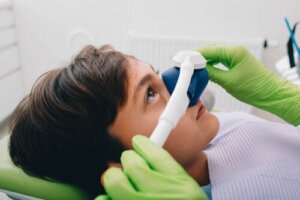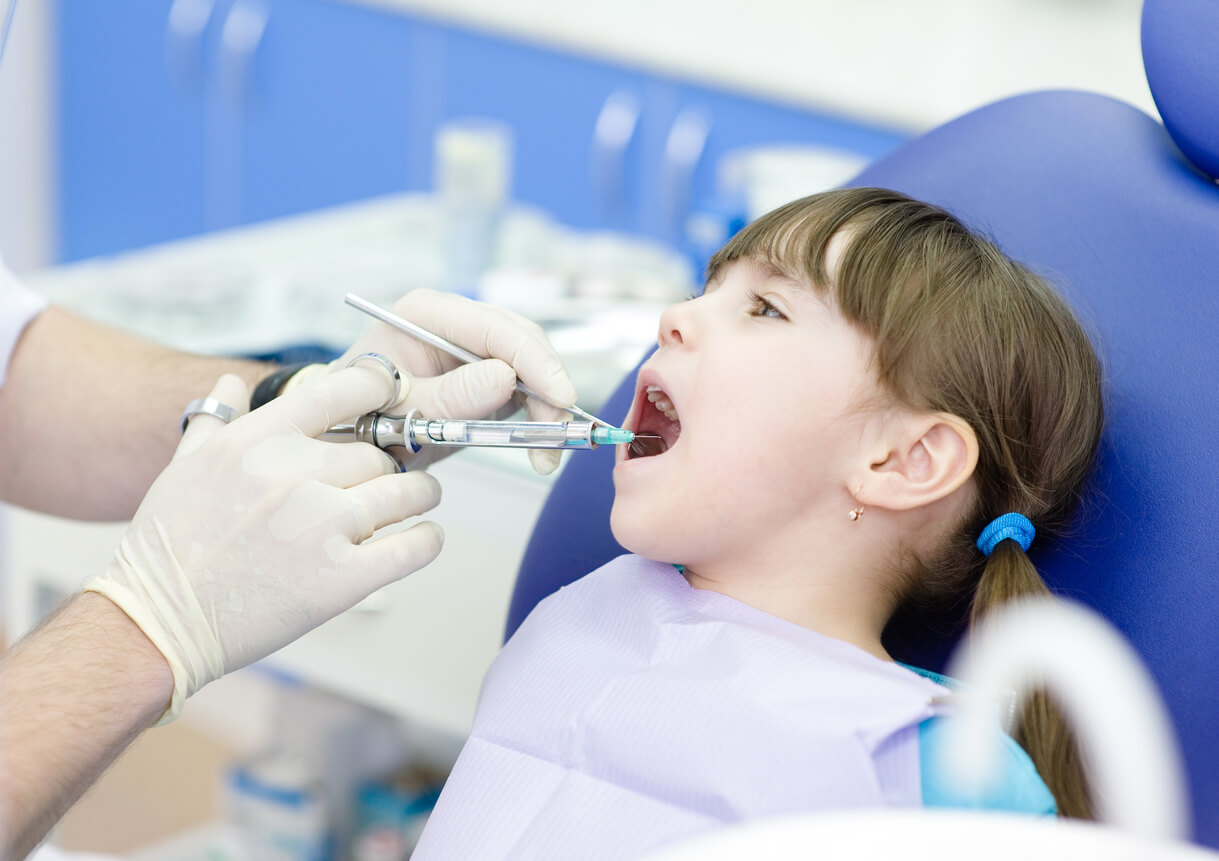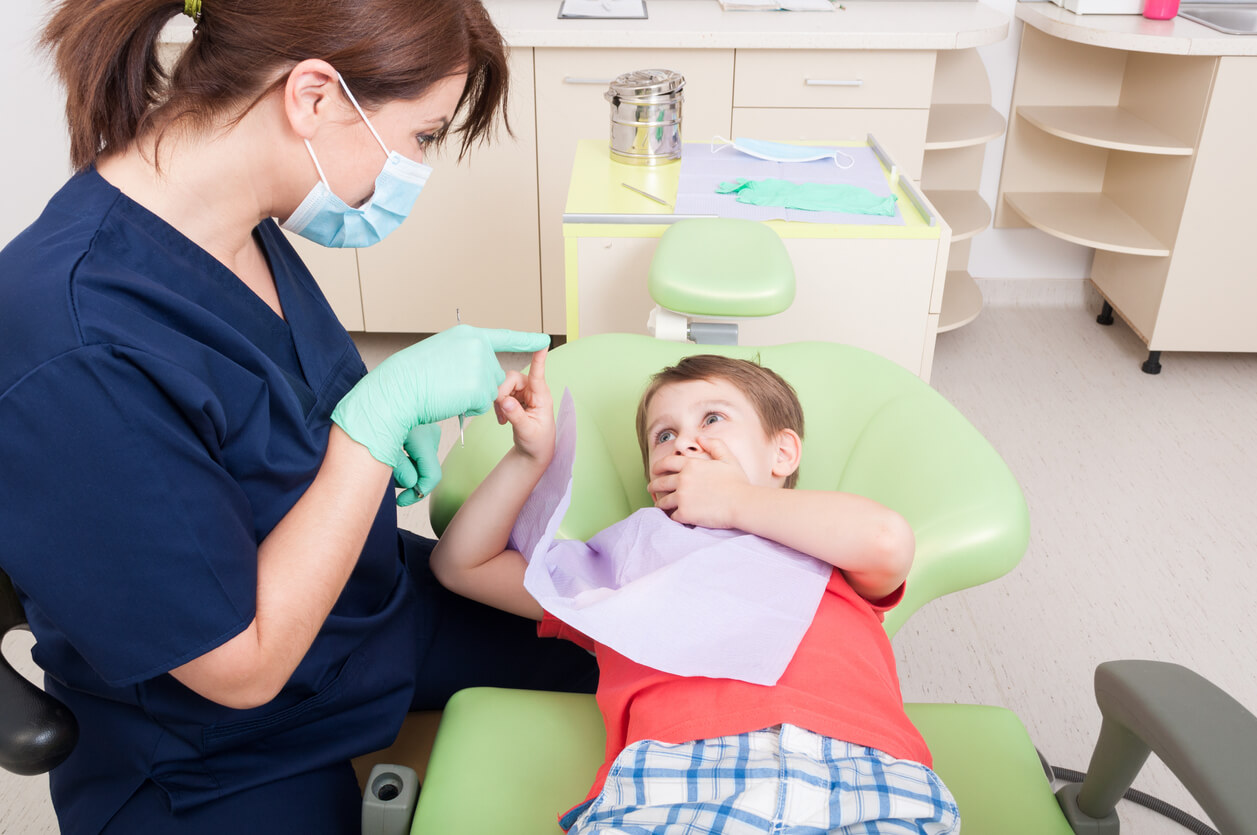Types of Dental Anesthesia in Children


Written and verified by the dentist Vanesa Evangelina Buffa
In order for dental care in children to be painless and pleasant, it’s often necessary to use different types of dental anesthesia. In this way, it’s possible to perform the relevant treatments comfortably, safely, and without causing fear in the little ones.
When children present oral diseases it’s important to treat them immediately. However, some procedures may frighten children, cause them discomfort, and require them to remain still for a long time. Fortunately, there are specific techniques and different medications that allow complex treatments to be performed on infants without causing them discomfort or fear. In this article, we’ll tell you all about them.
What are the different types of dental anesthesia for children?
Dental anesthesia in children’s dental care is a procedure used to eliminate sensitivity in some part of the mouth. In this way, the pediatric dentist can perform the necessary treatments without causing pain or discomfort to the patient. To prevent sensitivity in the area to be treated, a specific medication that reversibly inhibits nerve conduction is used. In this way, the sensation of pain is blocked.
In some cases, the child remains awake, especially when they’re able to cooperate with the dentist. In other cases, however, in addition to not feeling pain, the child is sedated or unconscious. In this way, they remain immobile and procedures can be performed safely. With the different types of anesthesia, it’s also possible to make the experience pleasant, avoid fear, and prevent negative opinions about dental visits.
What types of dental anesthesia are used in children?
The main objective of the use of different types of dental anesthesia in children is to provide safe, pleasant, and painless treatment. Depending on the particularities of each child, the pediatric dentist can choose between different alternatives.
In some cases, it’s possible to perform treatments by blocking pain in the area to be treated. Other cases, however, require resorting to sedation techniques. In specific cases, other anesthetic techniques that put the patient into a state of deep sleep may be necessary. Here are the different types of dental anesthesia and sedation methods most commonly used in the dental care of children.

Local anesthesia
This is one of the most commonly used types of anesthesia in dentistry. This technique allows numbing the area of the mouth that’s going to receive the therapeutic procedure. It consists of the application of a liquid that acts on the nerves of the cavity thus blocking the conduction of painful stimuli, which prevents patients from feeling discomfort. In children, it’s used to perform fillings in cavities, endodontics, and dental extractions.
The disadvantage of local anesthesia is that its application requires pricking the mouth with a needle. This procedure can be uncomfortable or frightening for some children. When it’s applied, it numbs the entire area near the site to be intervened. This effect lasts from 1 to 2 hours, depending on the anesthetic used and the amount used. Then, it disappears completely.
Topical anesthesia
These types of dental anesthesia are frequently used in children. Unlike the previous ones, they don’t require a needle prick to act. They’re applied directly on the oral mucosa by contacting the epithelial tissue and are able to numb the area. They’re marketed in the form of creams, gels, or sprays, with different components and in different concentrations. Evidence indicates that lidocaine is one of the most common drugs.
These anesthetics have a mild, limited, and short-lasting effect. That’s why, in general, their use is combined with other techniques. In pediatric dentistry, they’re used before applying a local anesthetic to reduce the pain of the puncture. They’re also useful to reduce the nauseous effect of some children when taking an impression of their mouth.
Mild sedation with nitrous oxide
This is another type of dental anesthesia that’s frequently used in children. It involves the administration of a mild sedative, called nitrous oxide, combined with oxygen. Its application is simple and comfortable. It consists of inhaling the gas through a mask. The gas mixture helps little ones to relax. In addition, they remain conscious and are able to cooperate and respond to the dentist’s indications.
It’s common that, as an effect of the sedative, children feel happy and laugh. For this reason, the medication is also known as “laughing gas”. However, in some children, it can cause dizziness or discomfort.
According to a review published in the Revista Salud Militar, this technique is useful for children who are fearful, stressed, nervous, or anxious. The relaxed state will help them to remain still, have a better experience, and not remember the treatment as an unpleasant situation. If necessary, this technique is combined with the application of local anesthetics that prevent them from feeling pain during specific treatments.

Sedation
Sedation consists of the application of certain medications to depress the nervous system, calm the children, keep them still, and induce sleep. The procedure is performed by a professional who follows guidelines published in 2019 by the American Academy of Pediatrics (AAP) and the American Academy of Pediatric Dentistry (AAPD) to provide sedation or anesthesia safely.
The pediatric dentist can choose between different types of sedation:
- Mild or conscious: Consists of administering a medication that relaxes the child. The child remains awake, so they can do what the dentist asks. Afterward, the child may not remember many details of the procedure.
- Moderate: Makes children more sleepy and relaxed. However, they breathe on their own, can do what the dentist tells them to do, and wake up easily with little or no memory of the procedure.
- Deep: This technique uses intravenous medications that help the child sleep for 2 or 3 hours.
General anesthesia
General anesthesia is a technique that temporarily suppresses the sensation of the whole body and is accompanied by loss of consciousness. The child is completely asleep and doesn’t experience any discomfort. This procedure is performed by an anesthesiologist in a hospital setting.
This alternative isn’t as widely used but is taken into consideration in order to solve those specific situations in which the other options aren’t possible or convenient. It’s useful in patients who can’t open their mouths by themselves, have a physical or mental disability, require complex surgeries, or need multiple treatments.
The most appropriate option
Having different types of dental anesthesia for use in children allows them to receive comfortable, safe, and painless care. Pediatric dentists can assess the particularities of their patients and choose the option that best suits their needs.
In any case, as an article published in the Revista de Odontología Mexicana makes clear, these are options that are used on specific occasions. Pediatric dentists have other methods and techniques that facilitate the collaboration and peace of mind of the little ones without having to use medication. Remember that in children’s dental care, times are different and patience is key.
In order for dental care in children to be painless and pleasant, it’s often necessary to use different types of dental anesthesia. In this way, it’s possible to perform the relevant treatments comfortably, safely, and without causing fear in the little ones.
When children present oral diseases it’s important to treat them immediately. However, some procedures may frighten children, cause them discomfort, and require them to remain still for a long time. Fortunately, there are specific techniques and different medications that allow complex treatments to be performed on infants without causing them discomfort or fear. In this article, we’ll tell you all about them.
What are the different types of dental anesthesia for children?
Dental anesthesia in children’s dental care is a procedure used to eliminate sensitivity in some part of the mouth. In this way, the pediatric dentist can perform the necessary treatments without causing pain or discomfort to the patient. To prevent sensitivity in the area to be treated, a specific medication that reversibly inhibits nerve conduction is used. In this way, the sensation of pain is blocked.
In some cases, the child remains awake, especially when they’re able to cooperate with the dentist. In other cases, however, in addition to not feeling pain, the child is sedated or unconscious. In this way, they remain immobile and procedures can be performed safely. With the different types of anesthesia, it’s also possible to make the experience pleasant, avoid fear, and prevent negative opinions about dental visits.
What types of dental anesthesia are used in children?
The main objective of the use of different types of dental anesthesia in children is to provide safe, pleasant, and painless treatment. Depending on the particularities of each child, the pediatric dentist can choose between different alternatives.
In some cases, it’s possible to perform treatments by blocking pain in the area to be treated. Other cases, however, require resorting to sedation techniques. In specific cases, other anesthetic techniques that put the patient into a state of deep sleep may be necessary. Here are the different types of dental anesthesia and sedation methods most commonly used in the dental care of children.

Local anesthesia
This is one of the most commonly used types of anesthesia in dentistry. This technique allows numbing the area of the mouth that’s going to receive the therapeutic procedure. It consists of the application of a liquid that acts on the nerves of the cavity thus blocking the conduction of painful stimuli, which prevents patients from feeling discomfort. In children, it’s used to perform fillings in cavities, endodontics, and dental extractions.
The disadvantage of local anesthesia is that its application requires pricking the mouth with a needle. This procedure can be uncomfortable or frightening for some children. When it’s applied, it numbs the entire area near the site to be intervened. This effect lasts from 1 to 2 hours, depending on the anesthetic used and the amount used. Then, it disappears completely.
Topical anesthesia
These types of dental anesthesia are frequently used in children. Unlike the previous ones, they don’t require a needle prick to act. They’re applied directly on the oral mucosa by contacting the epithelial tissue and are able to numb the area. They’re marketed in the form of creams, gels, or sprays, with different components and in different concentrations. Evidence indicates that lidocaine is one of the most common drugs.
These anesthetics have a mild, limited, and short-lasting effect. That’s why, in general, their use is combined with other techniques. In pediatric dentistry, they’re used before applying a local anesthetic to reduce the pain of the puncture. They’re also useful to reduce the nauseous effect of some children when taking an impression of their mouth.
Mild sedation with nitrous oxide
This is another type of dental anesthesia that’s frequently used in children. It involves the administration of a mild sedative, called nitrous oxide, combined with oxygen. Its application is simple and comfortable. It consists of inhaling the gas through a mask. The gas mixture helps little ones to relax. In addition, they remain conscious and are able to cooperate and respond to the dentist’s indications.
It’s common that, as an effect of the sedative, children feel happy and laugh. For this reason, the medication is also known as “laughing gas”. However, in some children, it can cause dizziness or discomfort.
According to a review published in the Revista Salud Militar, this technique is useful for children who are fearful, stressed, nervous, or anxious. The relaxed state will help them to remain still, have a better experience, and not remember the treatment as an unpleasant situation. If necessary, this technique is combined with the application of local anesthetics that prevent them from feeling pain during specific treatments.

Sedation
Sedation consists of the application of certain medications to depress the nervous system, calm the children, keep them still, and induce sleep. The procedure is performed by a professional who follows guidelines published in 2019 by the American Academy of Pediatrics (AAP) and the American Academy of Pediatric Dentistry (AAPD) to provide sedation or anesthesia safely.
The pediatric dentist can choose between different types of sedation:
- Mild or conscious: Consists of administering a medication that relaxes the child. The child remains awake, so they can do what the dentist asks. Afterward, the child may not remember many details of the procedure.
- Moderate: Makes children more sleepy and relaxed. However, they breathe on their own, can do what the dentist tells them to do, and wake up easily with little or no memory of the procedure.
- Deep: This technique uses intravenous medications that help the child sleep for 2 or 3 hours.
General anesthesia
General anesthesia is a technique that temporarily suppresses the sensation of the whole body and is accompanied by loss of consciousness. The child is completely asleep and doesn’t experience any discomfort. This procedure is performed by an anesthesiologist in a hospital setting.
This alternative isn’t as widely used but is taken into consideration in order to solve those specific situations in which the other options aren’t possible or convenient. It’s useful in patients who can’t open their mouths by themselves, have a physical or mental disability, require complex surgeries, or need multiple treatments.
The most appropriate option
Having different types of dental anesthesia for use in children allows them to receive comfortable, safe, and painless care. Pediatric dentists can assess the particularities of their patients and choose the option that best suits their needs.
In any case, as an article published in the Revista de Odontología Mexicana makes clear, these are options that are used on specific occasions. Pediatric dentists have other methods and techniques that facilitate the collaboration and peace of mind of the little ones without having to use medication. Remember that in children’s dental care, times are different and patience is key.
All cited sources were thoroughly reviewed by our team to ensure their quality, reliability, currency, and validity. The bibliography of this article was considered reliable and of academic or scientific accuracy.
- Bahar, E., & Yoon, H. (2021). Lidocaine: a local anesthetic, its adverse effects and management. Medicina, 57(8), 782. https://www.mdpi.com/1648-9144/57/8/782
- Bedolla, S. B. M., & Baeza, Ó. E. M. (2020). Seguridad del paciente bajo anestesia en el consultorio dental. Revista Odontológica Mexicana, 24(1), 30-41. https://www.medigraphic.com/pdfs/COMPLETOS/odon/2020/uo201.pdf#page=32
- Borrero Morales, A. I., Garnica Hilarión, Á. N., Guevara Obregón, R., Hernández Aguilar, L. M., & Reyes Pico, A. M. Revisión sistemática para la elaboración de protocolos de técnicas anestésicas en odontología. https://repository.usta.edu.co/handle/11634/12661
- Coté, C. J., & Wilson, S. (2019). Guidelines for monitoring and management of pediatric patients before, during, and after sedation for diagnostic and therapeutic procedures. Pediatric dentistry, 41(4), 26E-52E. https://publications.aap.org/pediatrics/article/143/6/e20191000/37173/Guidelines-for-Monitoring-and-Management-of?autologincheck=redirected
- Di Gregorio, M. M. (2021). Sistemas de anestesia local en odontopediatría. https://titula.universidadeuropea.com/handle/20.500.12880/654
- Maldonado-Ramírez, M. A., Issasi-Hernández, H., Trejo-Tejeda, S., & Morales-Sánchez, L. A. (2017). Eficacia de dos anestésicos tópicos, de uso dental, en pacientes pediátricos. Acta pediátrica de México, 38(2), 83-90. https://web.archive.org/web/20180428114408id_/http://www.medigraphic.com/pdfs/actpedmex/apm-2017/apm172b.pdf
- Soto, D., Chourio, F., & Pino, R. (2022). Administración de Anestésicos Locales en Odontopediatría. Revista digital La Pasión del Saber, 12(21), 55-67. https://lapasiondelsaber.ujap.edu.ve/index.php/lapasiondelsaber-ojs/article/view/38
- Yarzábal, T., Alzate, I., & Mussini, P. (2018). Óxido nitroso: uso en odontología. Salud Militar, 37(2), 46-54. https://revistasaludmilitar.uy/ojs/index.php/Rsm/article/view/6
This text is provided for informational purposes only and does not replace consultation with a professional. If in doubt, consult your specialist.








